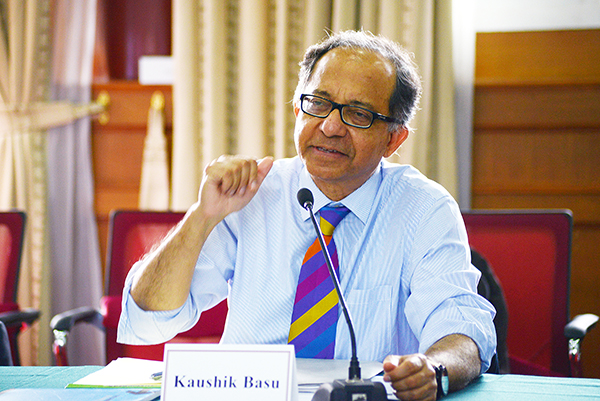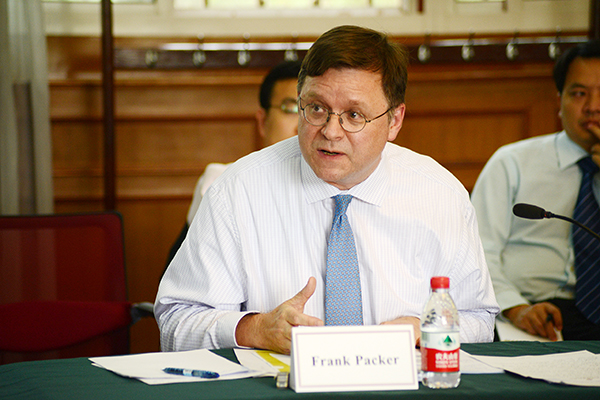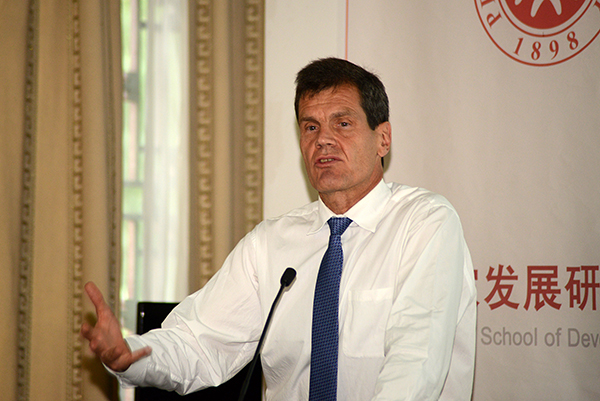

On the afternoon of 12th September, 2014, the Chief Economist Forum: China’s Development Outlook and Reform Agenda, hosted by Peking University’s National School of Development was held at Peking University’s Wanzhong Building.

Experts who attended and spoke at the forum include: Kaushik Basu, World Bank Vice President & Chief Economist; Vincent Koen, OECD Head of Country Studies Division 3; Jurgen Conrad , Head of the Economics Unit, PRC resident mission of the Asian Development Bank, former World Bank Senior Vice President & Chief Economist; Justin Lin Yifu, former World Bank Senior Vice President & Chief Economist, Standing Committee Member of the CPPCC, Vice Chairman of the National Federation of Industry and Commerce, State Council Counselor and Honorary Dean of the National School of Development of Peking University; Frank Packer, head of Economics and Financial Markets at the BIS Representative Office for Asia and the Pacific; Markus Rodlauer, Deputy Director of the IMF’s Asia and Pacific Department (APD); Peter Petri, Professor at Brandeis University; Ha Jiming, Vice President at Goldman Sachs (Asia); Peng Wensheng, Chief Economist at China International Capital Corporation and Professor Huang Yiping, Deputy Dean at the National School of Development, Peking University.

The first speaker was Kaushik Basu, World Bank Vice President & Chief Economist. Mr. Basu stated that before 1978, the volatility of the Chinese economy was incredibly high. After the structural reform of 1978, China began its 30 years of very low volatility and fast growth. Now, economic growth has somewhat slowed - according to a World Bank report, China’s economic growth rate will be approximately 7% in the period of 2015-2017. Future challenges for China include the transition of investment-led growth to innovation led-growth; the opening up of the RMB and the issue of government and private debt which have already reached 250% of GDP. It is important to take note of China’s high level of liabilities, but it is not inevitable that they cause a serious problem as Chinese government debt is relatively low.

The second speaker was Vincent Koen, Head of Division, Country Studies Division 3, OECD. He believes that Chinese economic growth rates will be 7.5% and 7.25% in this year and next year, respectively. This is in line with the World Bank’s forecast. Structural issues will be key factors in influencing the growth of the Chinese economy. China’s legal retirement age is too low, cutting supply of labor to the market and, given future shortages of labor, the large trend will be raising the age of retirement. To promote innovation, China needs to invest more capital into fundamental research and increase patent quality and quantity. China has already made great progress in deregulation, but compared to developed countries, it still has a long way to go. In particular, the financial sector must liberalize its deposit rates.

The third speaker was Jurgen Conrad, Head of the Economics Unit, PRC resident mission of the Asian Development Bank. In his view, it is very hard to reach a consensus on issues such as those relating to China’s growth potential and the development trend of the real estate industry. Perhaps the only thing that can be agreed upon is the uncertainty that surrounds China’s economy. Setting a growth target range (i.e. 7-7.5%) is a good method which can avoid the issue policy makers utilizing unnecessary stimulus policies to reach a single growth target rate. To accelerate economic growth, China must implement financial reform, increase retirement age and increase the quality of labor. China has been making economic growth more inclusive and environmentally friendly for a long time, and successfully.

The fourth speaker was Professor Justin Lin Yifu, former World Bank Senior Vice President & Chief Economist, Standing Committee Member of the CPPCC, Vice Chairman of the National Federation of Industry and Commerce, State Council Counselor and Honorary Dean of the National School of Development of Peking University. Professor Lin believes the Chinese economy’s volatility prior to 1978 was due to the government’s unrealistic aim of prioritizing political targets ahead of economic targets. After 1978, China was able to enjoy 30 years of sustained high economic growth due to a strict adherence to its competitive advantage. The Solow model of growth cannot fully explain China’s growth. China’s sustained high level of investment and high returns on investment suggest a high level of technological advances. As for recent slowing growth rates, this cannot be simply tied to internal structural issues, neither can it be taken as evidence of China’s economic collapse. The main reason for China’s slowing growth is external factors and has the ability to overcome internal structural issues. It has the potential for a sustained annual growth rate of 8% for the next 15 to 20 years, though of course potential is not always realized. In the current environment, China can realize a growth rate of 7-7.5%.

The fifth speaker was Frank Packer, head of Economics and Financial Markets at the BIS Representative Office for Asia and the Pacific. He presented the concept of a financial cycle. The financial cycle can sustain for 15-20 years, compared with the 1-8 years of a business cycle. It is clear that China is in the upper boom stage of the financial cycle, but there are signs that this stage will soon end. The BIS summarized some early-warning indicators for a Chinese banking crisis. Even if none of these indicators are reliable, they do show that China is relatively precarious position.

The sixth speaker was Markus Rodlauer, Deputy Director of the IMF’s Asia and Pacific Department (APD). Mr. Rodlauer spoke on a few points on China’s economic growth and reform: China’s economic growth relies heavily upon economic policy; rebalancing of the economy and reform both have a high impact on growth, and, at the same time, have created a negative impact on growth; China needs to change political encouragement relating GDP growth with government promotions to a new model in order to realize better quality growth.

The seventh speaker was Peter Petri, Professor at Brandeis University. He stated that China is an open economy, which is interwoven with the global trading environment. The progress of negotiations relating to China and international trade agreements are facing many challenges, but at the same time have had positive results. What is needed now is a stronger change agent, a leader. International trade agreement negotiations have many political factors which can become obstructions, for example trade union resistance and NGO protests. The internet and social media can be used, to an extent, to solve these issues.

The eighth speaker was Ha Jiming, Vice President at Goldman Sachs (Asia). Mr. Ha emphasized that investment makes up 48% of GDP, much higher that the highest levels of Japan and Korea in the last century, so it is inevitable that it drops. Aside from this, China’s economy faces challenges including: the population dividend which is changing to a deficit, the end of the real estate boom, increased debt burdens and increasing labor costs.

The ninth speaker was Peng Wenshen, Chief Economist at China International Capital Corporation. He believes that China’s low inflation shows that its current relatively slow economic growth is not because of supply restrictions and demand factors are important. In the long-term, threats to demand include the aging population and unequal spread of income. Currently, there is an overreliance on government investment which may increase the income gap, having a negative impact on economic growth.

The tenth speaker was Professor Huang Yiping, Deputy Dean at the National School of Development, Peking University. Professor Huang presented how liberalization of the financial industry will affect the Chinese economy. China’s financial restraints are very high, compared to both middle income economies and high-income economies; this situation is unsustainable. Financial liberalization will stimulate economic growth but may also lead to capital outflows, increasing financial risk.
